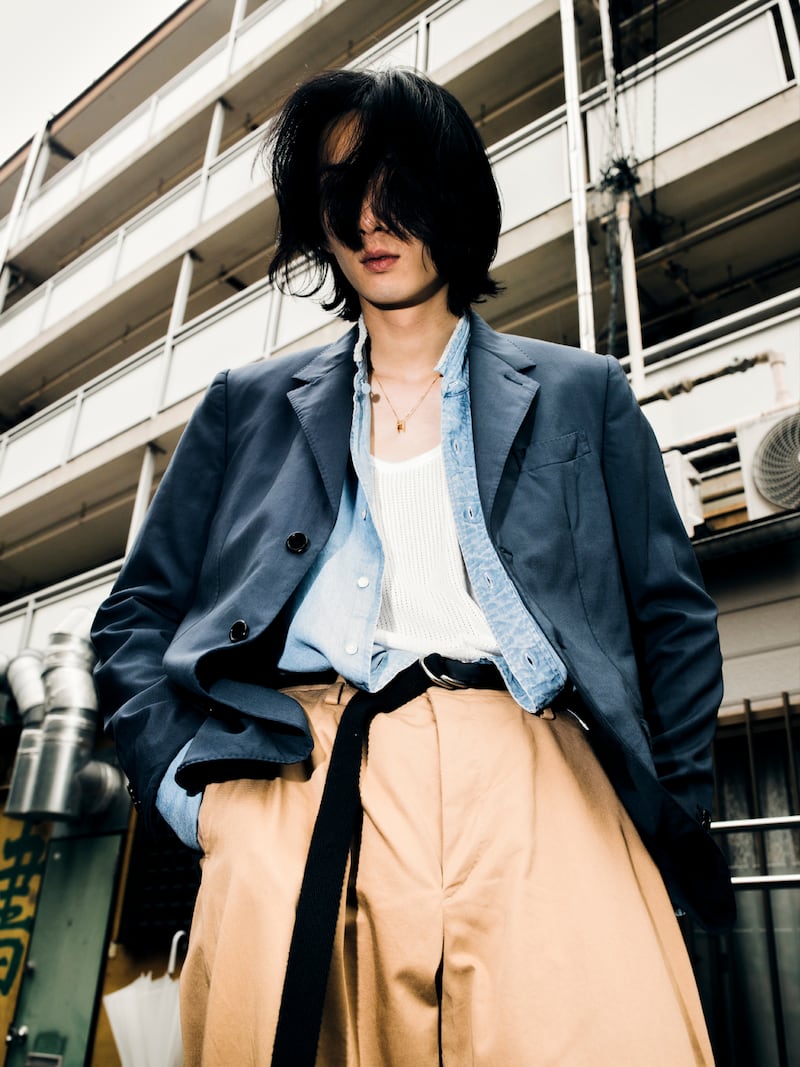
The Business of Fashion
Agenda-setting intelligence, analysis and advice for the global fashion community.

Agenda-setting intelligence, analysis and advice for the global fashion community.

FLORENCE — “A mixture of comfort with casual elegance”: That’s how Jian DeLeon, men’s fashion director at Nordstrom, described the prevailing trends in menswear as seen at Pitti Uomo this week.
The June 2023 edition of the semi-annual Florence trade show brought together menswear insiders from buyers to street-style aficionados alongside esteemed luxury houses like Brunello Cucinelli and technical outdoor brands such as Snow Peak and Goldwin.
The gathering was the first time since the pandemic that brands, buyers and press from key Asian markets were able to travel thanks to the lifting of Covid-19 travel restrictions earlier this year: Buying teams from coveted retailers like United Arrows and Beams of Japan were present en masse. Meanwhile, China’s reopening made a significant impression: 58 companies and 163 attendees from the country were present last week, compared to just a handful of attendees last summer, Pitti chief executive Raffaello Napoleone told BoF.
Looking to cash in on increased footfall from international buyers, 825 brands exhibited their new collections, up from the 680 that showed last summer. The brands and buyers also came out to take the temperature of a menswear market in flux.
ADVERTISEMENT
While the menswear market is expected to remain on fire—growing 5.8 percent to $548 billion annually for the next four years according to Euromonitor, trends in the key category are changing fast. The decline of logomania and brand tribalism has seen many streetwear brands lose heat — and sales — while a return to more elevated styles of dressing is seeing a resurgence as men’s tailoring and formalwear businesses modernise their offering.
Suits are always in style at Pitti—previously the locus of “#menswear” and a magnet for peacocking Instagram dandies. But this year saw renewed energy around the category as brands offered a more contemporary take, filled with relaxed “soft” suiting, often paired with t-shirts and casual shoes, or more casual, expressive shirting.
“I think in menswear we’re seeing a blurring of the categories which is evident here at Pitti,” said Napoleone. “It’s no longer about suiting, casual and sportswear being for separate consumers — we’re now in a world where men can wear all three at the same time.”
The blurring of formal and casualwear was exemplified at Fendi’s show on Thursday night, which championed tailoring with a contemporary spin. Held at sunset at the brand’s new production facility in the Tuscan countryside, models walked the runway through aisles of machinery in loose-fitting, workwear-inflected shapes rendered in luxe suiting fabrics—paired with sneakers and “Crocs”-style clogs. Instead of artistic director Silvia Venturini Fendi appearing to take the bow after the finale, the staff working at the machines joined the models on the runway to rapturous applause.
Later that evening, Eli Russell Linnetz — Pitti’s guest designer — continued the theme of casual tailoring, but this time adapted for euphoric partywear. In his first ever IRL runway show, the LA-based designer sent surfer-dude models out in rhinestoned silver trousers, silky, see-through shirting, and sleeveless jackets.
Buyers at Pitti said brands were responding to changing perceptions as to the role of suiting and tailoring in men’s daily wardrobes.
“Customers realise that they can shop for tailoring they actually want to wear, rather than feel like they have to,” said Nordstrom’s DeLeon. “This has encouraged people to be a bit more expressive with their wardrobes, and opting for garments that complement their personal style, which more and more is leaning towards a mixture of comfort with casual elegance.”
As the pandemic has receded, demand for casual suiting has soared even among buyers of ultra-luxe made-to-measure suiting as wealthy consumers look to elevate their wardrobes while projecting a cooler image and clinging to post-pandemic standards for comfort.
ADVERTISEMENT
Storied Florentine tailor Liverano and Liverano made its debut at the trade show to much excitement among buyers, signalling a shift of traditional brands catering to more casual suiting consumers.

Former Valentino and Zegna designer Aldo Maria Camillo presented his namesake brand’s second collection at Pitti this year, and said he was taken aback by the demand he’d already received for his brand’s avant-garde wide-shouldered, double-breasted suit jackets and baggy tailored trousers, which models paired with a simple vest underneath. The brand, run in partnership with United Arrows co-founder Hirofumi Kurino and based between Paris and Tokyo, is already stocked at over 15 retailers including Tokyo’s Dover Street Market Ginza and United Arrows, and last week had conversations with buyers from Selfridges and Bergdorf Goodman as it looks to expand in Western markets, Camillo told BoF.
Some bigger suiting brands, such as Italian formalwear maker Kiton, are also seeing soaring sales. The Neapolitan company was present at Pitti last week to promote its lifestyle sub-label KNT, which blends sports-inspired clothing with formalwear. After seeing unprecedented demand over the last year-and-a-half for both its suiting and casualwear, boosted by the viral quiet luxury aesthetic, the company expects to generate revenues of €200 million ($218.9 million) this year, up from €160 million in 2022.
“2022 was a record year for us,” said chief executive Antonio De Matteis. “Men are far more intentional now in the way they dress and this has led to new growth opportunities.”

One of the biggest draws of the trade show was Brunello Cucinelli’s “Bohemian Evolution” collection for spring-summer 2024. The brand covered its bases, leaning into the occasionwear boom with silk tuxedos and phasing out sneakers almost entirely to focus on derby shoes, loafers and brogues. But the collection also featured 1970s-inspired travel outfits such as shell tracksuits and sweaters once worn by tennis pros. The brand’s daywear suiting took on a more casual look this season, with shirts and T-shirts cropped shorter, paired with loose, wide-legged trousers. Finally, there was a luxury athleisure capsule dedicated to racquet sports.
Buyers agree that Italian formalwear brands like Cucinelli are well placed to cash-in on the “quiet luxury” dressing craze—a TikTok-fuelled discourse that has celebrated ultra-luxe yet logo-free fashion.
“Cucinelli is a really key brand for us,” said Thom Scherdel, a menswear buyer at Browns. “The Italian lifestyle mood translates really well into that aspirational European, English or American consumer who really wants to buy into that elevated aesthetic.”
Even outdoors brands — which in recent years have ridden a wave of popularity from streetwear fans for their technical clothing covered in zips, multiple pockets and logos — are adapting their product offerings to keep up with menswear’s new normal.
ADVERTISEMENT
Japanese outerwear label Goldwin for example, is seeing growing popularity in its lifestyle category for newly introduced products such as its minimalistic, baggy suit separates made from ultra-lightweight wool and bamboo fibre. Rather than the typically loud gorpcore fair consumers have come to expect in recent years, the rest of the brand’s collection is intentionally minimal and predominantly offers toned-down colourways like charcoal grey and navy blue. The idea was to design technical gear that consumers could blend with more formal pieces, such as shirts and loafers, said Takuya Kinami, the brand’s general manager.
“We can expect to see a lot more soft tailoring from outdoor brands who can bring some really interesting products through using technical fabrics,” said Chris Fisher, head of ready-to-wear menswear buying at Browns.
Fellow Japanese gorpcore favourite Snow Peak garnered attention from buyers for its similarly minimalist collection, as did Italian technical streetwear start-up Off Grid.
“The streetwear consumer isn’t necessarily trading up to Zegna. It’s sort of back to the era where items like the workwear pant and oxford shirt were the preferred flex,” said DeLeon. “Streetwear has always had a symbiotic relationship with the rest of the fashion world, and more subdued offerings in the market reflect that.”
From casualisation to the decline of streetwear, BoF unpacks what’s driving the “unprecedented” boom in the men’s market.
Luxury brands may have pivoted away from sneakers, puffer jackets and hoodies, but new brands like Corteiz and Free The Youth are making the case for street culture’s enduring relevance in fashion.
Fragmentation is, paradoxically, the strongest through line in menswear today, writes Angelo Flaccavento.

Daniel-Yaw Miller is Senior Editorial Associate at The Business of Fashion. He is based in London and covers menswear, streetwear and sport.
The deal is expected to help tip the company into profit for the first time and has got some speculating whether Beckham may one day eclipse her husband in money-making potential.
The designer has always been an arch perfectionist, a quality that has been central to his success but which clashes with the demands on creative directors today, writes Imran Amed.
This week, Prada and Miu Miu reported strong sales as LVMH slowed and Kering retreated sharply. In fashion’s so-called “quiet luxury” moment, consumers may care less about whether products have logos and more about what those logos stand for.
The luxury goods maker is seeking pricing harmonisation across the globe, and adjusts prices in different markets to ensure that the company is”fair to all [its] clients everywhere,” CEO Leena Nair said.